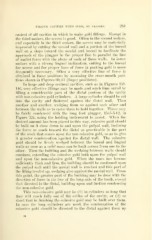Page 585 - My FlipBook
P. 585
FILLING CAVITIES WITH GOLD, BY CLASSES. 281
easiest of all cavities in which to make gold fillings. Except in
the third molars, the access is good. Often in the second molars,
and especially in the third molars, the access may he materially
improved hy cutting the mesial wall and a portion of the buccal
wall on a slope toward the mesial and buccal to facilitate the
approach of the plugger in the proper line to parallel the line
of mallet force with the plane of each of these walls. In lower
molars with a strong lingual inclination, cutting to the buccal
for access and for proper lines of force iu packing gold is more
frequently necessary. Often a very elTective line of force is
obtained in these positions by assuming the cross-mouth posi-
tions shown in Figures 60, 61 (finger positions).
In large and deep occlusal cavities, such as in Figures 138-
146, very effective fillings may l)e made and much time saved by
filling a considerable part of the distal portion of the cavity
with non-cohesive gold cylinders. A large cylinder should be set
into the cavity and flattened against the distal wall. Then
another and another, wedging them so against each other and
between the walls as to cause them to hold together. These may
be fairly condensed with the long foot plugger, 15x5-5-12, in
Figure 324, using the holding instrument to assist. "Wlien the
desired amount has been placed in this way, cohesive gold should
be built on it close down to and upon the pulpal wall, inclining
the force as much toward the distal as practicable in the part
of the work that comes upon the non-cohesive gold, so as to give
it greater condensation against the distal wall. The cohesive
gold should be firmly wedged between the buccal and lingual
walls as soon as a solid mass can be built across from one to the
other. Then the building and the wedging between walls should
continue, extending the cohesive gold both upon the pulpal wall
and upon the non-cohesive gold. When the mass has become
sufficiently thick and firm, the building should be continued upon
the pulpal wall until the mesial wall is reached and this part of
the filling leveled up, wedging also against the mesial wall. From
this point, the greater part of the building may be done with the
direction of force in the line of the long axis of the tooth, except
that directed to the distal, building upon and further condensing
the non-cohesive gold.
This non-cohesive gold may be (1) in cylinders so long that
they will reach fully out of the orifice of the cavity, or (2) so
short that in finishing the cohesive gold may be built over them.
In case the long cylinders are used, the condensation of the
cohesive gold should be directed to the distal against them up
38


